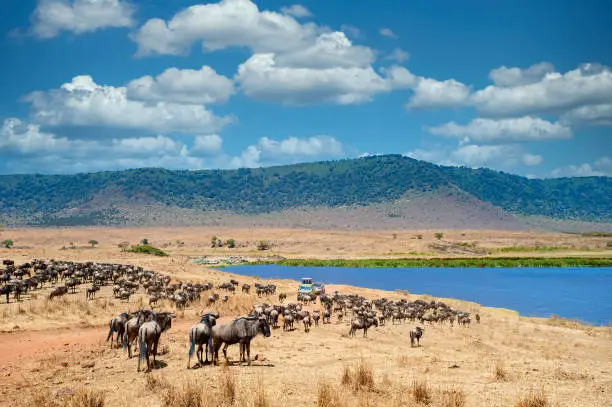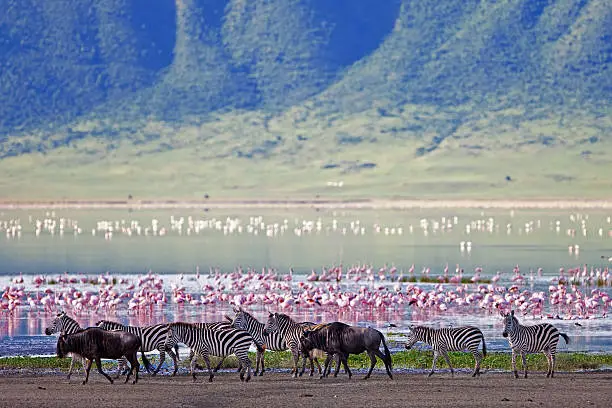Ngorongoro Crater
A Comprehensive Guide for Travelers
The Ngorongoro Crater is one of the most iconic and extraordinary destinations in Tanzania, and indeed in all of Africa. Formed approximately 2 to 3 million years ago when a massive volcano exploded and collapsed on itself, this ancient caldera is now the world’s largest intact volcanic crater, and one of the richest wildlife viewing areas on Earth. As a UNESCO World Heritage Site and a central feature of the Ngorongoro Conservation Area (NCA), the crater attracts thousands of travelers each year, offering a safari experience unlike any other.
Location and Geography
Located in northern Tanzania, about 180 kilometers west of Arusha, the Ngorongoro Crater is part of the greater Serengeti ecosystem. The caldera is approximately 19 kilometers (12 miles) in diameter, and the crater floor covers about 260 square kilometers. The crater rim rises to about 2,200 meters (7,200 feet) above sea level, while the floor lies around 1,800 meters—resulting in a dramatic natural amphitheater encircled by lush highlands.
The Ngorongoro Conservation Area Authority (NCAA) works hard to balance tourism, conservation, and the rights of local people. Travelers directly support conservation efforts through park fees, and some lodges partner with local organizations to support community-based tourism, healthcare, and education.
The Ngorongoro Crater offers a safari experience that is both highly concentrated and deeply moving. From its geological origins to its role in modern conservation and culture, it’s a place where history, wildlife, and humanity intersect in powerful ways. Whether it’s your first safari or a return journey to Tanzania, no visit to the Northern Circuit is complete without standing on the edge of the crater rim and descending into its storied heart.
Often referred to as “Africa’s Eden”, the crater supports a staggering density of wildlife. It’s home to an estimated 25,000 large animals, making it one of the best places in Tanzania to see the Big Five: lion, leopard, elephant, buffalo, and black rhino.
- Lions thrive in the crater, and it’s one of the few places in Africa where lions can be seen in such high concentration.
- Black rhinos, critically endangered elsewhere, are easier to spot here, making it one of the best places in East Africa to see them in the wild.
- Elephants, particularly older bulls, roam the forests and grasslands.
- Leopards are more elusive but can occasionally be spotted in the forested areas around the rim.
- Buffalos graze widely across the plains.
In addition to these, the crater also harbors hyenas, jackals, cheetahs, hippos, wildebeest, zebras, gazelles, and an abundance of birdlife. The seasonal Lake Magadi in the center of the crater often hosts flocks of flamingos, while more than 500 bird species have been recorded in the conservation area.
The Ngorongoro Crater is a year-round
destination, but the best months for wildlife viewing are during the dry
season (June to October) when animals are easier to spot in the thinner
vegetation and congregate around water sources.
The wet season (November to May)
brings lush landscapes and newborn animals, but some roads may be more
difficult to traverse, and clouds can obscure views from the rim. However, this
is also the low tourist season, so it may offer a more peaceful
experience and lower accommodation rates.
The Ngorongoro Conservation Area is
unique in that it allows both wildlife and people to coexist. The Maasai
people, with their iconic red shukas and cattle herding traditions, have lived
in harmony with the region’s wildlife for centuries. Visiting a Maasai boma
(homestead) is a popular cultural add-on, giving travelers a glimpse into a
traditional semi-nomadic lifestyle and the deep cultural ties that bind the
local people to the land.
- Park fees are relatively high due to its UNESCO status and
conservation efforts. - Game drives typically begin at 6:00 am and must exit the
crater by 4:00 pm. - Temperatures can be chilly on the rim—pack layers.
- Binoculars and a camera with a
zoom lens are essential for spotting
distant wildlife. - Travel with a certified tour
operator to ensure proper permits,
guides, and knowledge.
Most safaris to the crater begin in Arusha,
a gateway city in northern Tanzania. From Arusha:
- The drive takes 3.5 to 4
hours via well-maintained roads. - Domestic flights from Arusha or Kilimanjaro International Airport to Lake
Manyara Airstrip or Ngorongoro Airstrip are available, followed
by a short drive to the crater.
Ngorongoro is often included as part
of a Northern Circuit safari, along with Tarangire, Lake Manyara,
and the Serengeti.
You’ll find a range of
accommodations both on the rim of the crater and in nearby Karatu
town, which is about a 30-minute drive from the park gate. Staying on the
rim offers incredible sunrise views and faster access into the crater.
Lodge categories include:
- Luxury lodges (e.g., &Beyond Ngorongoro Crater Lodge, The
Highlands) - Mid-range safari lodges
- Budget-friendly tented camps
and lodges
Most lodges include full board,
and some even offer cultural tours, guided walks, or visits to community
projects.




